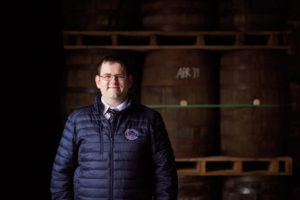
Distiller Graham Omand talks the past, present and future of Lagg Distillery
GRAHAM Omand, distillery manager at Lagg Distillery on Arran, has been around the whisky business his entire life.
Brought up on Islay, Omand told SLTN he lived “very much a whisky kind of life” until he was 18.
“All my family – my mum, my brother, my uncle, my cousins, my nephew, everyone in the family apart from my dad, has always worked in distilleries,” he said.
“My mother ran a bed and breakfast – that was our home. So when I was a boy I always knew how important the whisky industry was because we were getting German, Norwegian, Japanese tourists coming to stay in my mum’s wee house.”
After earning a degree in biotechnology Omand made the – perhaps inevitable – move into the industry himself with a role at Arran Distillers’ Lochranza Distillery.

The job, as a stillman, saw him learn at the feet of his uncle, whisky veteran James MacTaggart.
“I learned a lot from James,” Omand told SLTN. “I would never be where I am now without him. He taught me everything about, not just the finer points of distillation, but the cask management.
“That was very important. Good cask and good wood policies were something he brought to this company and we’ve continued it.
“You can make the nicest whisky in the world but if you put it in a terrible, third-fill bourbon cask, you’re not going to get anything good in 20 years time.”
That knowledge and experience has been put to good use as manager of Lochranza’s sister distillery, Lagg.
The facility, which began production in 2019, released its first whisky earlier this year.
The yin to Lochranza’s yang, Lagg produces heavily peated spirit in contrast to Lochranza’s unpeated whisky. It’s something that was built into the design of the facility from the very beginning, said Omand.
“We wanted a more earthy, heavy body,” said Omand. “More oily. Something that would tie in well with the heavy phenols that we were looking for from the heavily peated malt. Because we knew from the get-go Lagg was going to be a heavily peated malt.”
Achieving the different flavour and texture of the spirit is an involved process. Differently shaped stills play a part, but the crafting of the body and flavour begins before distillation.
Omand explained he intentionally designed the production procedure to create the “oily, fatty, grassy notes” found in the Lagg single malt.
“I didn’t want to encourage too many ester notes, because that’s what Lochranza does,” he said.
“At Lochranza, when you’re mashing in and when you’re draining off the wort for fermentation, if you want sweet, flowery, estery notes you don’t want to disturb it. You want to leave it to have its own natural drain channel through the mash. A nice, clear wort, with not many particles through it, will give you what Lochranza is.
“I wanted to be counter to that, so we agitate the mash. We have the rakes going constantly. We try to maximise a cloudy wort.
“What that will do is that will allow a lot more of the [fatty acids] through and that will create more of an oily and grassy note characteristic to come through in the end.”
Even with his procedure in place, however, there was no guarantee the spirit would emerge from the stills exactly the way Omand wanted it. Or that the flavours would develop the way he had hoped during the three years it takes to become whisky.
Fortunately, the early signs have been encouraging.
“A lot of people say that the spirit is densely oily on the tongue,” said Omand. “You almost chew it, which is a character I was really wanting. I wanted that lasting smoke to cling to your tongue and your throat as it goes down.
“That was one of the success stories when I tried the spirit after three years. Yes, it worked! I was so glad!
“It’s heavy, smoky, earthy. There is a bit of sweetness to it, but that’s mostly from the bourbon barrels.
“From the second fill casks you can definitely tell there’s a lot more smoke there. It punches you right in the face.”
The first small-batch release of Lagg’s single malt had been fully matured in ex-bourbon barrels from Buffalo Trace in Kentucky.
However, batches two and three, which were due for release as SLTN went to press, have been finished in specially-designed 50 litre firkin casks.
To put the size of those casks into perspective, a standard bourbon barrel will hold up to 200 litres, with a hogshead taking around 250 litres and a sherry butt around 500 litres.
Some of these firkin casks were seasoned with Oloroso sherry, the others with Rioja wine.
The Oloroso-finished whisky will be released as batch two, with the Rioja casks released as batch three.
“They’re very special,” said Omand.
“The science behind maturation, generally, is that the smaller the cask the more influence the wood and the seasoning on the wood will have on the spirit.
“So these three year-old malts are going to turn some heads when they come out.”
Exploring different finishes is something Isle of Arran Distillers has become known for, with Lochranza Distillery having released a number of wine-finished expressions through the years.
Omand said that’s very much a tradition he wants to continue at Lagg.
As a new distillery it could be some time before Lagg has a ‘core range’ of expressions established, but the distiller said he would like to see some wine-finished releases “peppered in between” the standard bottlings in the years to come.
“I’d like in ten years time for Lagg to be seen as, not a competitor and not something different, but hand in hand with Lochranza,” he said.



















